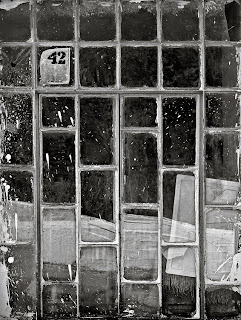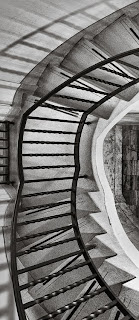
Faithful followers of my humble blog have, over the years, read a number of entries that mention my dad in one way or another. My dad (
Slava "Sam" Ilachinski) - who passed away in 2002, but is never far from my thoughts, and continues to inspire me - was a lifelong artist, and an art restorer by trade (doing it the "old fashioned" way, sans computers and algorithms ;-) I recall times when essentially pitch-black canvases entered my dad's studio and emerged - weeks, sometimes months, afterward - as though they were just created (which in many cases they nearly were, given how much paint my dad had to add by his own hand in order to "complete" missing fragments of the original). I saw firsthand many a seasoned professional artist's jaw drop after witnessing the product of my dad's amazing talent. While he labored in relative obscurity for much of his professional life (though NY galleries all knew of his work), my dad had an occasional opportunity to work on some well-known pieces. The most famous of these is
Leutze's Washington Crossing the Delaware, which he worked on in the 70s.
It is therefore fitting, in a partly ironic and partly, poetically Uroborian sort of way, that I - certainly not an artist (in my dad's sense) - and he (certainly not a photographer, in my sense) - should meet again so many years after his death on the cusp of a discipline he so loved -
restoration - and a digital photo technique I would likely never have taken the time to learn but am doing so now only because I wish to write a book on my dad's life and art!
My mom, who I am lucky enough to still have with me, is both a storehouse of rich memories and (her home is a) warehouse of old - and frequently badly dilapidated - family photos. While scanning this "warehouse" was easy, and "cleaning it up" was almost as simple (in truth, the process can be thought of as only a slightly more involved version of the more usual "touching up" of any print, analog or digital), when it came to serious retouching and full-blown restoration I was soon out of my league.
Two valuable resources I now keep on my PC's shelf are the second edition of Ctein's
Digital Restoration from Start to Finish, and the third edition of Katrin Eismann's
Adobe Photoshop Restoration & Retouching. Though they overlap in parts, each has its own focus, and both books offer a tremendous number of examples and practical advice on how to recover images. Ctein is a master printer and an exceptionally clear writer on technical matters (click
here for his website, and links to his gallery and other works; he also frequently contributes to Mike Johnston's
The Online Photographer blog).
Eismann is an all-around Photoshop guru and has many other wonderful books to her credit. While I would not have been completely lost without these two fine guides, my task would certainly have been considerably more difficult and daunting.
The image reproduced at the top of this blog is a
before and
after comparison between an "as is" scan of an old print of my dad when he was 4 years old; in the picture, he is standing in front of his dad (a medical doctor). The original picture was taken in
Taganrog, Russia in 1929, where my dad was born (Taganrog is also the birthplace of
Anton Chekov). The "after" shot represents what I was able to pull out of it after about an hours' worth of restorative work. It is not perfect, and I'm sure my skills will improve in time, but I am very happy to have injected a bit of
life into an old family photo from a bygone era. One down, and - oh, about a 100 or so ! - to go ;-) My resolution for the coming year is to complete the book on my dad's life and art that my mom and I have slowly been working on for the last few years.
Postscript #1: One of the great regrets of my life is not ever having trained my camera on my dad
while he worked in his studio! I've rationalized away this grievous - and unforgivable! - omission on my part in countless ways over the years. I was too young; I was "afraid" of what he'd say if I asked; I was always "going" to do it, when I had a better camera; I was waiting for a chunk of time I could devote entirely to this series; ... none of it makes sense, of course, in hindsight, and the opportunity -
opportunities! - are now lost in the mists of time. Oh, what I wouldn't now give to have a few precious moments with a camera in hand and my dad hunched over one of his canvases! This is also the reason why I so cherish the following "newly restored" image: it is the
only photograph - taken ~1980 -
I have of my dad working as an art restorer (with a bonus capture of my mom peering over the top left edge of the painting)!
 Postscript #2:
Postscript #2: Some of my dad's abstract work from the last five years of his life can be sampled
here. A catalog of the 35 works that are now the property of the
Taganrog Museum (bequeathed by my dad, and lovingly delivered by my mom a few years ago) in Taganrog, Russia, can be seen
here. One of my
dad's regrets was never having revisited his boyhood city, which he left as a young boy. So it is fitting that, with my mom's help, a generous selection of his creative efforts has found its way back home! My dad's very
last work (that was still on his easel the day he went to the hospital for the last time) is a simple, joyful celebration of color and motion. It perfectly reflects everything my dad's art was -
is - about.
 "On the day of the Great On-Turning two soberly dressed programmers with briefcases arrived. Their names were Lunkwill and Fook. For a few moments they sat in respectful silence, then, after exchanging a quiet glance with Fook, Lunkwill leaned forward and touched a small black panel. The subtlest of hums indicated that the massive computer was now in total active mode. After a pause it spoke to them in a voice rich, resonant and deep. It said: 'What is this great task for which I, Deep Thought, ... have been called into existence? ...'O Deep Thought computer,' Fook said, 'the task we have designed you to perform is this. We want you to tell us ...' he paused, 'the Answer!' 'The Answer?' said Deep Thought. 'The Answer to what?' 'Life!' urged Fook. 'The Universe!' said Lunkwill. 'Everything!' they said in chorus. Deep Thought paused for a moment's reflection. 'Tricky,' he said finally...
"On the day of the Great On-Turning two soberly dressed programmers with briefcases arrived. Their names were Lunkwill and Fook. For a few moments they sat in respectful silence, then, after exchanging a quiet glance with Fook, Lunkwill leaned forward and touched a small black panel. The subtlest of hums indicated that the massive computer was now in total active mode. After a pause it spoke to them in a voice rich, resonant and deep. It said: 'What is this great task for which I, Deep Thought, ... have been called into existence? ...'O Deep Thought computer,' Fook said, 'the task we have designed you to perform is this. We want you to tell us ...' he paused, 'the Answer!' 'The Answer?' said Deep Thought. 'The Answer to what?' 'Life!' urged Fook. 'The Universe!' said Lunkwill. 'Everything!' they said in chorus. Deep Thought paused for a moment's reflection. 'Tricky,' he said finally...






